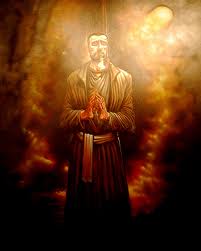
Summary: St John Ogilvie, convert, priest, tortured, martyr’d
John is the only Scot to be canonised a saint. Drawn to the Catholic faith while studying in France, he became a Jesuit and chose to return as a missionary to his own country, fully aware that his martyrdom was a distinct possibility.
Patrick Duffy tells his story.
Catholic and Presbyterian background
John was born into a family of mixed Catholic and Presbyterian background at Crum-na-Keith, Banffshire. His father sent him to France as a teenager so he could get the best Calvinist teaching, but on hearing the religious debates there, John was drawn more to the Catholic faith and admiration of those who were willing to die for it.
Conversion to Catholicism and education as a Jesuit
At 17 John became a Catholic and continued his education at the Scots College in Louvain, then with the Scots Benedictines at Regensburg, Germany, and finally with the Jesuits at Brno in the Czech Republic. Joining the Jesuits in 1599, he spent some years in Austria, was ordained a priest in Paris in 1610 and worked at Rouen, France.
Mission to Scotland
 At John’s request, his Jesuit superiors sent him to Scotland in 1613, as he writes of himself: ut dedocerem haeresim (“that I might unteach heresy”). He travelled in civilian clothes under the name of John Watson, posing now as a horse-dealer, now as a returning soldier. His first efforts were discouraging. Many of the Catholic nobles had gone over to the Reform under pressure. Eventually John returned to Paris to ask advice. His superior, Father Gordon, scolded him for leaving Scotland and ordered him to go back there at once, which he did.
At John’s request, his Jesuit superiors sent him to Scotland in 1613, as he writes of himself: ut dedocerem haeresim (“that I might unteach heresy”). He travelled in civilian clothes under the name of John Watson, posing now as a horse-dealer, now as a returning soldier. His first efforts were discouraging. Many of the Catholic nobles had gone over to the Reform under pressure. Eventually John returned to Paris to ask advice. His superior, Father Gordon, scolded him for leaving Scotland and ordered him to go back there at once, which he did.
Arrest and torture
On his return John lived with a prominent Catholic in Edinburgh and had some success urging Catholics to profess their faith. He undertook the risky ministry to Catholics in prison. In 1614 he went to Glasgow, where he lodged with Mrs. Marion Walker, a brave widow, who would later die in prison for having assisted him. However, in October 1614, a spy attending his Mass at Glasgow denounced him and he was arrested. Tortured by crushing his legs (‘the boot’) and by food- and sleep-deprivation for nine nights to make him betray the names of his Catholic friends, he did not yield.
 Trial and execution
Trial and execution
The authorities brought him to trial on a charge of high treason. Five questions bearing on relations between Church and State and supposedly drawn up by King James I were put to him, which he answered according to his conscience. He said he would die in defence of the king’s civil authority, but he could not obey him in spiritual matters. Condemned for high treason, John Ogilvie was hanged at Glasgow Cross on 10 March, 1615. He was buried secretly in a criminal’s plot, so no relics remain.
His canonisation
When the cause for the canonization of the English martyrs was introduced, the name of John Ogilvie was omitted, the Scots Catholics wishing to have their own process. Pope Pius XI declared him “blessed” in 1929 and Pope Paul VI canonised him in 1976.
____________________________________
******************************
Memorable Saying for Today
It is truer to say that martyrs create faith
more than faith creates martyrs.
~Miguel de Unamuno ~
******************************